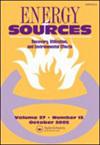通过与污水污泥厌氧共消化从废机油中回收生物能源:总固体量和接种物与基质比率的影响
IF 2.2
4区 工程技术
Q3 ENERGY & FUELS
Energy Sources Part A-recovery Utilization and Environmental Effects
Pub Date : 2024-09-02
DOI:10.1080/15567036.2024.2397506
引用次数: 0
摘要
考虑到它们的各种益处,如污染控制、废物管理和生态友好型能源生产,目前人们更多地关注如何利用一些城市、工业和农业废弃物。本文章由计算机程序翻译,如有差异,请以英文原文为准。
Bioenergy recovery from waste engine oil through anaerobic co-digestion with sewage sludge: Effects of total solids and inoculum to substrate ratio
Considering their various benefits, such as pollution control, waste management, and eco-friendly energy production, much more attention is currently devoted to utilization of some urban, industria...
求助全文
通过发布文献求助,成功后即可免费获取论文全文。
去求助
来源期刊
CiteScore
4.40
自引率
6.90%
发文量
488
审稿时长
1.7 months
期刊介绍:
Energy Sources Part A: Recovery, Utilization, and Environmental Effects aims to investigate resolutions for the continuing increase in worldwide demand for energy, the diminishing accessibility of natural energy resources, and the growing impact of energy use on the environment.
You are invited to submit manuscripts that explore the technological, scientific and environmental aspects of:
Coal energy sources
Geothermal energy sources
Natural gas
Nuclear energy sources
Oil shale energy sources
Organic waste from energy use
Petroleum
Solar energy sources
Tar utilization
Sand utilization
Wind energy.

 求助内容:
求助内容: 应助结果提醒方式:
应助结果提醒方式:


